The GDS setup operations are described below.
These setup operations can be performed in any sequence.
Setting Up System Disk Mirroring
Set up system disk mirroring by one of the following methods corresponding to the boot environment of the system.
Setting Up Shared Disks
Set up the shared disk volumes according to 6.3.2.3 Setting Up Shared Disks.
Note
When one or more single nodes for which the class has already been created are converted to the cluster system, the setting of GDS is needed.
For details, see "PRIMECLUSTER Global Disk Services Configuration and Administration Guide."
If mirroring a system disk under a ZFS boot environment, perform one of the following setups.
If mirroring under GDS
If registering to GDS and mirroring under ZFS
Refer to "PRIMECLUSTER Global Disk Services Configuration and Administration Guide."
The values to be set for each item are to correspond with those provided in "Setup (GDS System Disk Mirror)" of PRIMECLUSTER Designsheets.
Take the following setup procedures to enable system disk mirroring in the UFS boot environment.
The setup values correspond to the values that were specified in "Setup (GDS System Disk Mirror)" of PRIMECLUSTER Designsheets. In the operation procedure, "Setup (GDS System Disk Mirror)" of PRIMECLUSTER Designsheets is abbreviated as the designsheet.
See
For setup details, see "PRIMECLUSTER Global Disk Services Configuration and Administration Guide."
Operation Procedure:
Select Global Disk Services at the Web-Based Admin View top screen.
The GDS Management screen (hereinafter main screen) is displayed.

From the GDS configuration tree, select the node in which the system disk mirror is to be set, click the Settings menu, and select System Disk Settings.
A list of disks that can be used for mirrored disks for the selected node is displayed.
Select the system disk ("Physical disk name" on the designsheet), and click Next.

Specify class name of the root class.
Enter the class name ("Class name" on the designsheet) of the root class, and click Next.
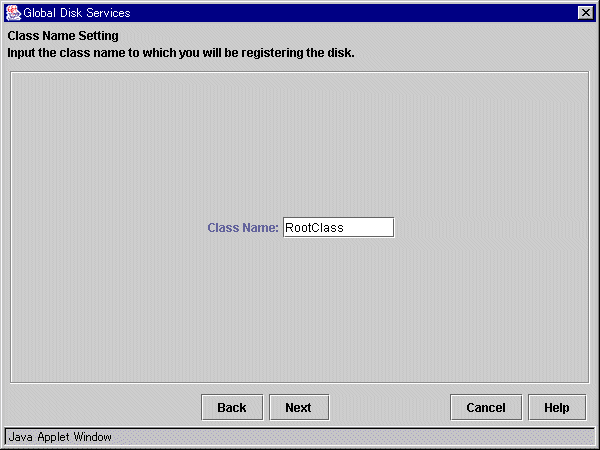
Note
Specify the class name so that the class names of the root class are not duplicated among cluster nodes.
Add a mirror disk to the group.
Enter the "Group Name" ("Group name" on the designsheet), then from the "Physical Disk List," select the "mirror disk" ("Mirror disk name" on the designsheet) for the system disk, and click Add.
Check that the "mirror disk" that was selected is displayed in "Group Configuration Disk," and then click Next.

Select a spare disk ("Spare disk name" on the designsheet) from the "Physical Disk List," and click Add.
Check that the spare disk that was selected is registered to "Spare Disk," and then click Next.
If a spare disk is unnecessary, go to Step 6.
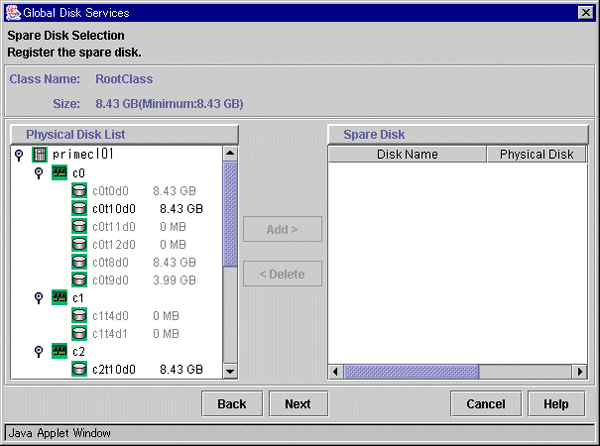
Check the system disk configuration.
Check the physical disk name and the mirror disk name, and then click Create.
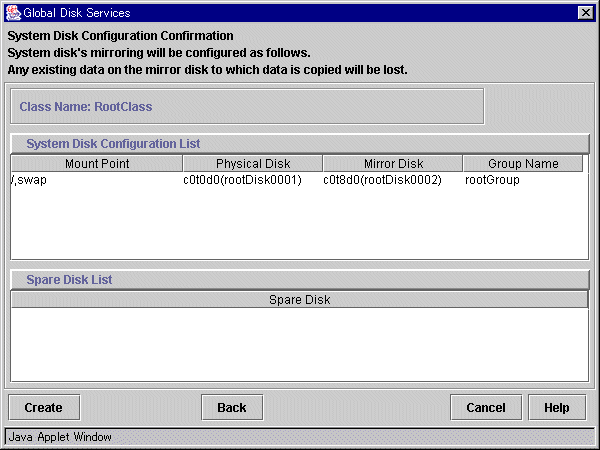
After creation of the system disk is completed, the following screen is displayed.
Check the screen contents, and then click OK.
Set up mirroring for the system disk of primecl02 on each node, and then, restart all the nodes.

Set up the shared disks according to the following procedures:
Volume setup
File system setup
There are four types of volumes:
Single volume
Mirror volume
Striped volume
Volume created in a concatenation group
This section separately describes the volume setup procedures for a single volume (a) and for other volumes (b, c, d). For details, see "PRIMECLUSTER Global Disk Services Configuration and Administration Guide."
The values to be set for the individual items correspond to the values in "Setup (GDS Local Class)" and "Setup (GDS Shared Class)" of PRIMECLUSTER Designsheets.
Note
If you plan to add, delete, or rename a disk class from the GDS Management screen (hereinafter main screen), close the Cluster Admin screen before starting the operation.
Single volume setup
If you are not using a single volume, this setup is unnecessary.
Operation Procedure:
Start the main screen
Choose Global Disk Services on the Web-Based Admin screen.
Disk class creation and physical disk registration
At the main screen, select Class Configuration from the Settings menu.
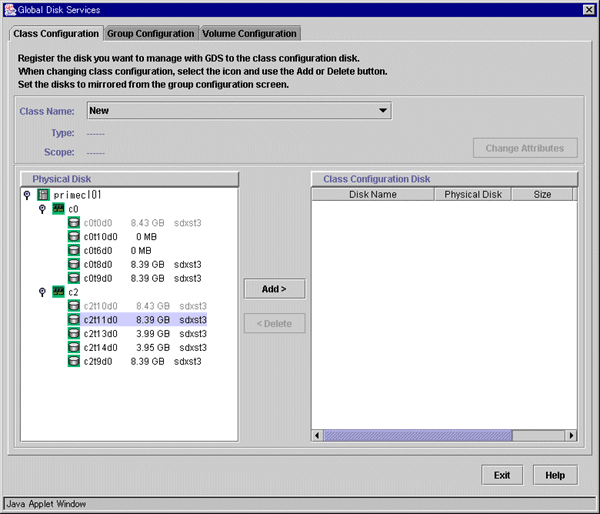
At the above screen, select the physical disk to be registered from the "Physical Disk" list, and then click [Add]. When [Add] is clicked, the class attribute definition screen opens. Perform and check the following settings in the class attribute definition screen.
Change "Class Name" if you need to change it.
Make sure that "Type" is set to "shared".
Make sure that the nodes accessing the class are displayed in "Scope".
For the class used in the userApplication, make sure that the nodes operated by the userApplication are displayed.
If the setting of "Scope" does not match the nodes accessing the class, click [Change Scope] to select the nodes accessing the class.
See
For how to change the scope, see "Cluster System Class Configuration" in "PRIMECLUSTER Global Disk Services Configuration and Administration Guide."
Click [Exit] after you finished the settings.
Disk type attribute setup
At the main screen, select the disk that was registered in Step 1 from the disk information field, and select Operation -> Change Attributes from the menu bar.

Set Disk Type to "single," and then click [OK].

Volume creation
Select Settings -> Volume Configuration, and then select the disk that was registered in Step 1 from the Group and Disk List. Select "Unused" in the volume diagram, and enter the "Volume Name," the "Volume Size," and the volume attributes.
Click [Add] to enable the settings.
Check the settings, and then click [Exit].

Setup for other volumes
If you are using only a single volume, this setup is unnecessary.
Operation Procedure:
Creating disk classes and registering physical disks
At the main screen, select Class Configuration from the Settings menu.

At the above screen, select the physical disk to be registered from the Physical Disk list, and then click [Add]. When [Add] is clicked, the class attribute definition screen opens. Perform and check the following settings in the class attribute definition screen.
Change "Class Name" if you need to change it.
Make sure that "Type" is set to "shared".
Make sure that the nodes accessing the class are displayed in "Scope".
For the class used in the userApplication, make sure that the nodes operated by the userApplication are displayed.
If the setting of "Scope" does not match the nodes accessing the class, click [Change Scope] to select the nodes accessing the class.
See
For how to change the scope, see "Cluster System Class Configuration" in "PRIMECLUSTER Global Disk Services Configuration and Administration Guide."
Click [Exit] after you finished the settings.
Setting up the disk group configuration
Click the Group Configuration tab.

At the above screen, select the disk to be added to the group from the Class Configuration Disk/Group list, and then click Add.
Enter the "Group Name", "Type" and "Stripe Width" in the group attribute definition screen, and then click [OK].
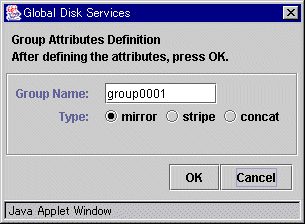
Creating a volume
Click the Volume Configuration tab, and select the group that was created in Step 2 from the Group and Disk List. Select Unused in the volume diagram, and enter the "Volume Name," the "Volume Size," and the volume attributes.
Click [Add] to enable the settings.
Check the setup information, and then click [Exit].
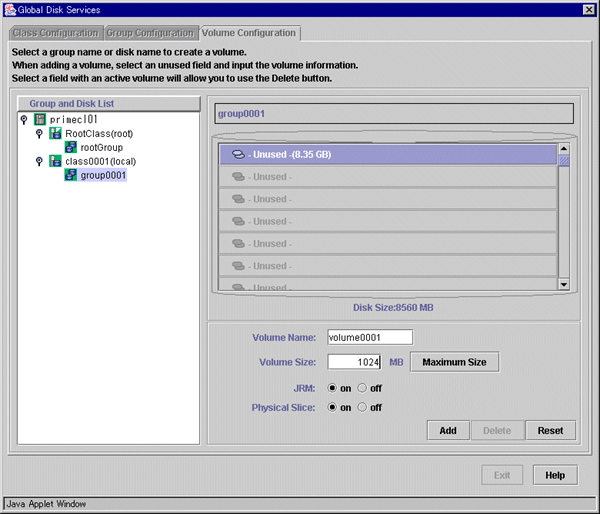
Checking the configuration
The disk configuration is displayed as shown below.
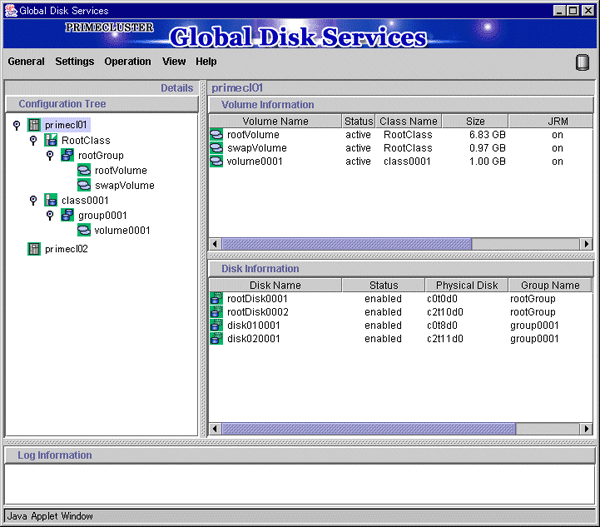
Create a file system for the created volume.
Example
When the class name is Class1, volume name is Volume1, and file system type is ufs.
# newfs /dev/sfdsk/Class1/dsk/Volume1See
For how to create a file system, see the manual of the file system.
To use ZFS, follow the procedures described in "6.4 Initial File System Setup" to set up the file system.